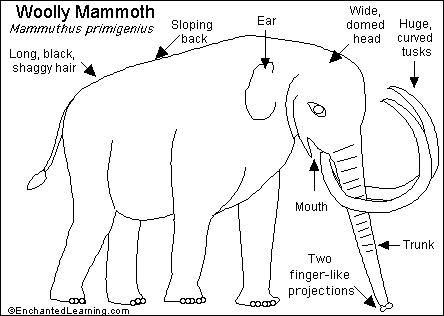
 |
| You might also like: | Woolly Mammoth | Saber-toothed Cat Printout | Today's featured page: Rainforest Classroom Activities |
| All about Mammoths | EnchantedLearning.com Woolly Mammoth Printout | Animal Printouts Label Me! Printouts |


Anatomy and Diet: Woolly mammoths had long, black, shaggy fur and two huge, curving tusks. The tusks were used for protection and for digging in the snow for grass and other food. Woolly mammoths were about 11.5 feet (3.5 m) long, 9.5 feet (2.9 m) tall at the shoulder and weighed about 3 tons (2.75 tonnes). They were larger than mastodons and modern-day elephants.
Adaptations to the Cold: Some of the obvious adaptations of the woolly mammoth to its cold, snowy environment were its long hair (which insulated its body and kept it warm), its long tusks (which it used to get food through the snow and ice, and also may have been used as protection), its small ears (which minimized heat loss), and its relatively large size (which also minimized heat loss).
Extinction: The woolly mammoth probably went extinct because it couldn't adapt to the combined pressures of the climatic warming that occured when the Ice Age ended, together with predation from humans.
| Search the Enchanted Learning website for: |